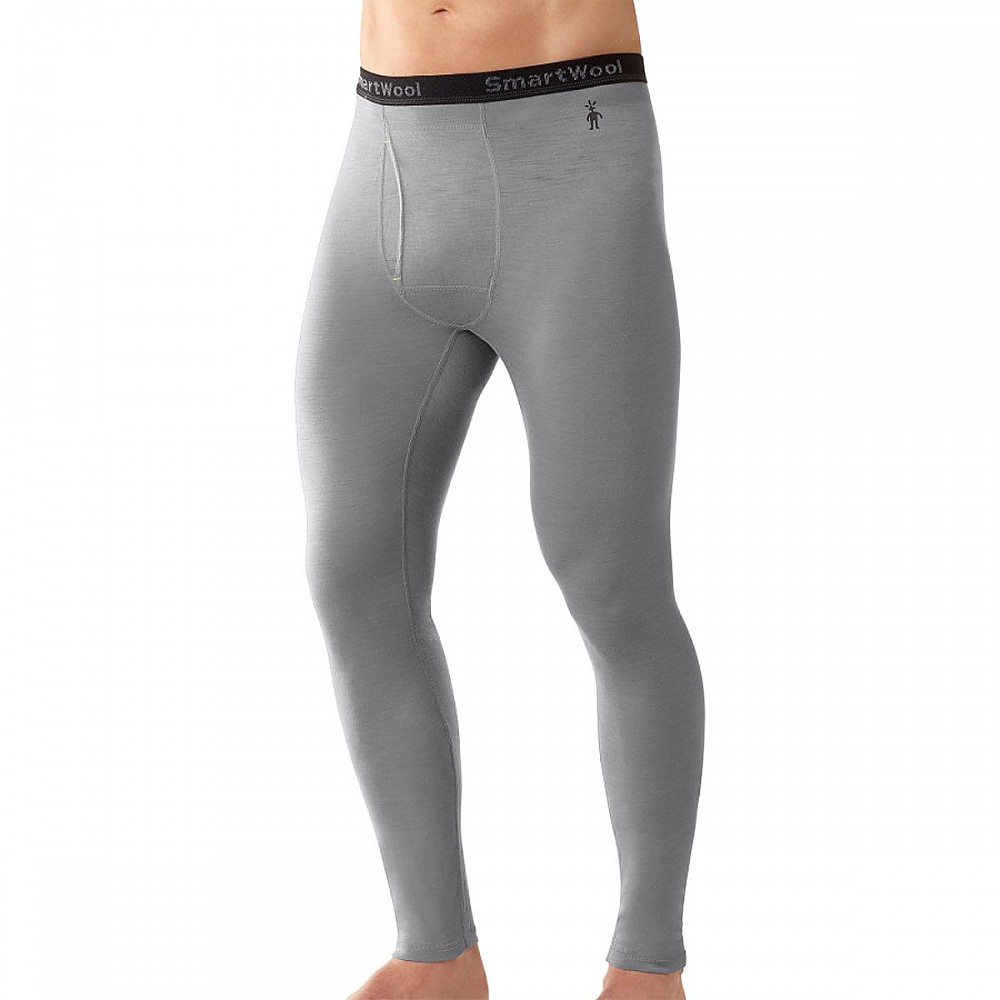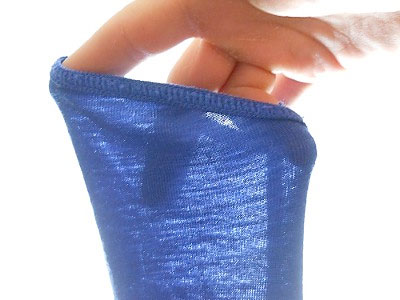Smartwool Men's Microweight Bottom

This microweight short-sleeve tee, made from SmartWool's NTS (next to skin) 150 g/sq m merino wool, can be used for days without building a noticeable smell, making it ideal for longer backpacking trips.
It excels in warmer temperatures and during more active pursuits. It also has stellar features like a tight-fitting, efficient cut, and ample-length in the legs (appreciated by us tall folks).
SmartWool also makes lightweight (195 g/sq m) NTS baselayers, with a slightly heavier weight, and midweight (250 g/sq m) NTS baselayers for cool to cold-weather conditions, or less active pursuits. (See also my reviews of the Microweight Crew, Microweight Tee, and Midweight Funnel Zip.)
Pros:
- Long legs, ample ankle coverage.
- Well-designed front access panel.
- Bio-mapping construction puts lighter-weight fabric in high-sweat and high-movement areas, and heavier fabric where more insulation or support is desired.
- Athletic cut keeps fabric close to skin, where it can remove the most moisture.
- Lower legs have lighter-weight fabric to prevent constriction around ankles when wearing multiple layers of clothing.
- Wool's natural odor prevention means less funk when compared to synthetics.
Cons:
- Have a “saggy crotch.”
Best For:
SmartWool's microweight baselayers are thin and light and excel in warmer temperatures and during more active pursuits, such as long-distance backpacking or hiking.
The microweight garments, applicable to a wide range of conditions, are best for users who appreciate a close-fitting, thin baselayer, and who want their baselayers to wick sweat, but prefer to leave the insulation to insulating layers.
Fabric & Fit
The Microweight Bottom provided ample leg and ankle coverage, solving a problem of many of the baselayers I’ve used in the past
It has great stitching all around, without any loose threads.
The cuffs are more than adequately reinforced. The garment appears “cut in the round,” where the panels are sewn to contour the body’s curves more truly than traditional construction might, as well as to minimize seams in between legs.
This tailored construction also creates a stable microclimate against the skin. Close-fitting garments trap a micro-layer of air against the skin, allowing the body to regulate its temperature more efficiently. When it is cold out, these tiny air pockets work to hold in warm air; when it’s warm, these pockets help circulate air, keeping the skin cool. This garment excelled in that regard.
The microweight (150 g/sq m) merino wool SmartWool uses is well suited to undergarments, more stretchy and supple than synthetic materials, with an excellent drape I don't find with synthetics. The fabric colors are bold and bright. The Microweight Bottom was a brilliant royal blue.
As a male, I appreciate a well-designed access panel in my long johns. Happily, the Microweight Bottoms incorporate a front access, which overlaps adequately, and allows one-handed operation. This area is well stitched, and should remain robust for the life of the garment.
Unfortunately, the bottoms suffer from an ailment common to many long johns: Saggy Crotch Syndrome. In order to get the crotch to an acceptable height, I had to pull the waistband over my bellybutton. It’s a bit ridiculous that the waistband needs to be rolled a half-dozen times. Why is it, after 20 years of wearing long johns, I can’t get pair that doesn’t make me look like Steve Urkel?
I understand the average wearer of the product may have a larger rear and belly than I, and I do want the waistband of my baselayer to come up above the waistband of my outer pants, but this was disappointing.

A close-up of the Smartwool baselayer fibers.
Wicking Ability
I’m always carrying a pack weighing at least 20 pounds, and my patrols as a Wilderness Ranger for the Bureau of Land Management in Colorado often involve intermittent periods of intense off-trail scrambling followed by leisurely on-trail walking.
The usual weather is 70-100°F, sunny, with little humidity. We get the occasional mid-afternoon Rocky Mountain rainstorm, and it can snow at any time in the highlands, so any baselayer I wear has to be able to capture, then disperse moisture very effectively. In this respect, this top performs admirably.
The SmartWool microweight garments use a very lightweight, nearly see-through, 150 g/sq m merino.
Because of its light fabrics and open weave, this bottom is very permeable to air. Worn under other layers, this same open weave helps to move moisture to outer layers, where it can further disperse.
Though this fabric is probably as heavy as a traditional silkweight fabric, here it is sewn in very small, parallel channels that raise the fabric off the skin. It increases airflow and moisture dispersion as a function of the increased surface area created by their wavy pattern. The weave is visibly looser than the other parts of the garments, if only because the weave of the fabric is responsible for the channels.
Warmth
As a ranger, wearing a set of baselayers under my button-down uniform comes in handy on days when I patrol on foot. Since I’m in the field literally every day, discerning the differences between the two was as easy as comparing Monday’s observations with Tuesday’s.
This layer usually kept me warm, with a few exceptions. Prior to the testing period, I wore a set of Patagonia Capilene 3 baselayers for about two years. The SmartWool top compared favorably to the Capilene in many respects.
On comparable days, this bottom was as warm as the comparable Capilene, due in part to the closer cut of the Smartwool, and the better coverage.
I also never missed the cold sweaty feeling that comes with every pause in physical activity when wearing the Capilene; the SmartWool layers seem to conserve that heat better, or, at least, don’t get cold when I stop to catch my breath.
Odor Resistance
The merino wool SmartWool uses does not build "the funk” as quickly as my Capilene 3. I actually make it a point to not wear any type of deodorant or antiperspirant on those days when I know I’ll be patrolling on foot, and on long days in the canyons, conditions can really stink up a baselayer.
However, I can wear the SmartWool layers for days without washing, which is something I could never try with the Capilene.
In fact, a particularly strenuous 8-mile out-and-back in a place called Rough Canyon usually leaves my Capilene tops in the laundry hamper. But on a recent visit while wearing the only the short-sleeved Microweight Tee under a pack, I came out smelling so fine that I wore it later on that day to the rock gym.
This is valuable to me as my days are often long and laundry is often low on my priority list. Plus, I just generally like the idea of having to spend less money on washing my clothes.
Durability
After approximately 30 days of wear and a dozen or so washings, this bottom hasn't stretched, shrunk, or otherwise deformed. All seams are intact, with no signs of fraying.
However, the Microweight Tee and Crew began to show piling beyond what I would have expected, though their thickness has not noticeably decreased.
This Microweight Bottom should give the average user a few seasons of regular use, which I think is a reasonable expectation for baselayers of this weight.
Conclusion
This microweight baselayer is everything I am looking for: very lightweight, very quick to dry, reinforced in key areas, resistant to smell. The bio-mapping construction appears to effectively allow the garments to hug the body while keeping seams away from high-friction areas.
This is not a fragile garment, and does not need to be babied. That this garment can be washed and dried in normal home laundry machines is brilliant.
Testing Conditions
I tested the SmartWool men's Microweight Crew, Microweight Tee, Microweight Bottom, and Midweight Funnel Zip all in size Medium.
Location: Canyons and highlands in and around the town of Grand Junction, Colorado, 3-5 mile in-town road runs in temperatures ranging from 45 to 85 degrees Fahrenheit, once a week. 3-30 mile hikes on and off-trail, in temperatures ranging from 40-75 degrees Fahrenheit, two or three times a week. 6-8 hour work patrols by foot, bike, and truck.
My Stats:
Weight: 165 lb
Height: 6'-1"
Chest: 37"
Sleeve: 33-1/2"
Inseam: 33"
Waist: 31"
Source: received for testing via the Trailspace Review Corps


